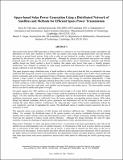Space-based solar power generation using a distributed network of satellites and methods for efficient space power transmission
Author(s)
McLinko, Ryan M.; Sagar, Basant V.
DownloadMcLinko-2010-Space-based solar power.pdf (296.9Kb)
PUBLISHER_POLICY
Publisher Policy
Article is made available in accordance with the publisher's policy and may be subject to US copyright law. Please refer to the publisher's site for terms of use.
Terms of use
Metadata
Show full item recordAbstract
Space-based solar power (SSP) generation is being touted as a solution to our ever-increasing energy consumption and dependence on fossil fuels. Satellites in Earth's orbit can capture solar energy through photovoltaic cells and transmit that power to ground based stations. Solar cells in orbit are not hindered by weather, clouds, or night. The energy generated by this process is clean and pollution-free. Although the concept of space-based solar power was initially proposed nearly 40 years ago, the level of technology in photovoltaics, power transmission, materials, and efficient satellite design has finally reached a level of maturity that makes solar power from space a feasible prospect. Furthermore, new strategies in methods for solar energy acquisition and transmission can lead to simplifications in design, reductions in cost and reduced risk. This paper proposes using a distributed array of small satellites to collect power from the Sun, as compared to the more traditional SSP design that consists of one monolithic satellite. This concept mitigates some of SSP's most troublesome historic constraints, such as the requirement for heavy lift launch vehicles and the need for significant assembly in space. Instead, a larger number of smaller satellites designed to collect solar energy are launched independently. A high frequency beam will be used to aggregate collected power into a series of transmission antennas, which beam the energy to Earth's surface at a lower frequency. Due to the smaller power expectations of each satellite and the relatively short distance of travel from low earth orbit, such satellites can be designed with smaller arrays. The inter-satellite rectenna devices can also be smaller and lighter in weight. Our paper suggests how SSP satellites can be designed small enough to fit within ESPA standards and therefore use rideshare to achieve orbit. Alternatively, larger versions could be launched on Falcon 9s or on Falcon 1s with booster stages. The only satellites that are constrained to a significant mass are the beam-down satellites, which still require significant transmission arrays to sufficiently focus the beams targeting corresponding ground stations. With robust design and inherent redundancy built-in, power generation and transmission will not be interrupted in the event of mishaps like space debris collision. Furthermore, the "plug and play" nature of this system significantly reduces the cost, complexity, and risk of upgrading the system. The distributed nature of smallsat clusters maximizes the use of economies of scale. This approach retains some problems of older designs and introduces additional ones. Mitigations will be explored further. For example, the distributed nature of the system requires very precise coordination between and among satellites and a mature attitude control and determination system. Such a design incorporates multiple beaming stages, which has the potential to reduce overall system efficiency. Although this design eliminates the need for space assembly, it retains the challenge of significant on-orbit deployment of solar and transmission arrays. Space power "beaming" is a three step process that involves: 1) conversion of dc power generated by solar cells on the satellite into an electromagnetic wave of suitable frequency, 2) transmission of that wave to power stations on ground, and 3) conversion of the radio waves back into dc power. A great deal of research has been done on the use of microwaves for this purpose. Various factors that affect efficient power generation and transmission will be analyzed in this paper. Based on relevant theory and performance and optimization models, the paper proposes solutions that will help make space-based solar power generation a practical and viable option for addressing the world's growing energy needs.
Date issued
2010-04Department
Massachusetts Institute of Technology. Department of Aeronautics and Astronautics; Massachusetts Institute of Technology. Department of MathematicsJournal
International Conference on Space Information Technology 2009,
Publisher
Society of Photo-optical Instrumentation Engineers
Citation
McLinko, Ryan M., and Basant V. Sagar. “Space-based solar power generation using a distributed network of satellites and methods for efficient space power transmission.” International Conference on Space Information Technology 2009. Ed. Xingrui Ma, Baohua Yang, & Ming Li. Beijing, China: SPIE, 2009. 76513P-7.©2010 SPIE--The International Society for Optical Engineering.
Version: Final published version
ISBN
9780819480798
ISSN
0277-786X